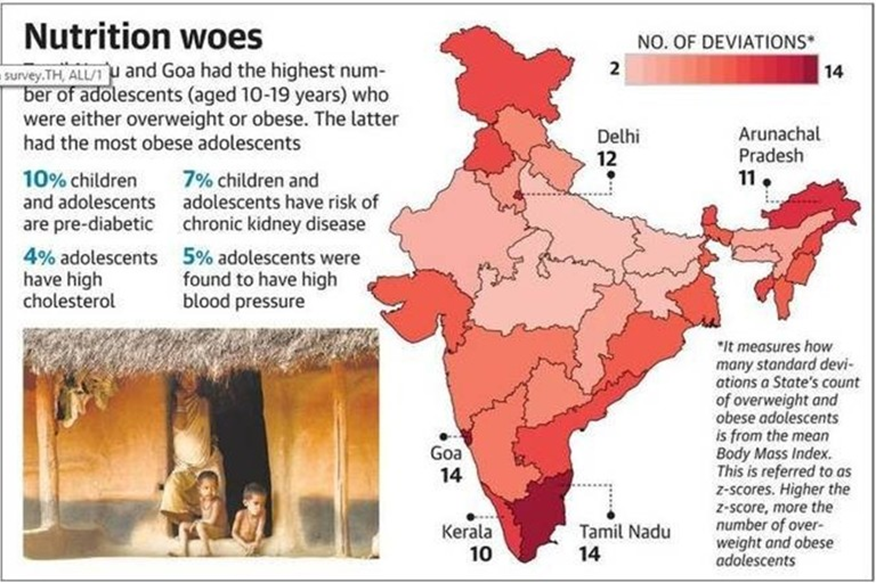MEASURING NUTRITIONAL DEFICIENCY AMONG THE POOR IN INDIA: INSIGHTS FROM HCES 2022-23
Syllabus:
- GS-2– Health and nutrition ,Children’s welfare, Growth of nation , sustainable development
Focus:
- This article focuses on measuring and understanding the nutritional deficiency among the poor in India using data from the HCES 2022-23. It emphasizes the need for targeted nutritional schemes to address this issue and improve the health of the poorest segments of the population.
Source-TH
Introduction
- Background: The National Sample Survey Office (NSSO) released a detailed report based on the Household Consumption Expenditure Survey (HCES) 2022-23.
- Data Collection: HCES collected data on quantities and values of food and non-food items consumed by households.
- Objective: Analyze the per capita daily calorie intake of lower expenditure classes and compare it with the average daily calorie requirement for a healthy life.
Defining ‘Poor’ and Nutritional Measurement
Defining ‘Poor’
- Committees: The Lakdawala, Tendulkar, and Rangarajan Committees have defined ‘poor’ in different ways.
- Lakdawala Committee: Anchored the poverty line to calorie norms (2,400 kcal/day for rural and 2,100 kcal/day for urban).
- Tendulkar Committee: Did not use a calorie norm for defining poverty.
- Rangarajan Committee: Based on adequate nourishment, clothing, house rent, conveyance, education, and other non-food expenses.
Measuring Nutritional Level
- Calorie Requirement: Based on the ICMR-National Institute of Nutrition’s 2020 report.
- Average Daily Per Capita Calorie Requirement (PCCR): Calculated as a weighted average of calorie requirements for different age-sex-activity categories.
- Periodic Labour Force Survey 2022-23: Used to estimate the proportion of persons in different categories.
Methodology of Analysis
- Step 1: Calculate the PCCR for rural and urban India.
- Step 2: Arrange estimated persons into 20 fractile classes of Monthly Per Capita Consumer Expenditure (MPCE), from poorest to richest.
- Step 3: Derive the average MPCE for food and non-food items for each class based on HCES 2022-23 data.
- Step 4: Establish the all-India total MPCE threshold for adequate nourishment and basic non-food items.
- Step 5: Adjust the all-India threshold for price differentials across States/UTs using Consumer Price Index numbers.
- Step 6: Calculate the proportion of ‘poor’/deprived persons for States/UTs and for the country as a weighted average.
Findings
- PCCR Estimates:
- Rural India: 2,172 kcal/day
- Urban India: 2,135 kcal/day
- Threshold Total MPCE (2022-23 Prices):
- Rural India: ₹2,197 (food: ₹1,569, non-food: ₹628)
- Urban India: ₹3,077 (food: ₹2,098, non-food: ₹979)
- Proportion of ‘Poor’/Deprived:
- Rural Areas: 17.1%
- Urban Areas: 14%
- Impact of Non-Food Expenditure on Poverty Threshold:
- For the poorest 10%, the threshold total MPCE increases, raising the proportion of deprived persons to 23.2% in rural areas and 19.4% in urban areas.
Nutritional Deficiency
- Calorie Intake of the Poorest 5%:
- Rural India: 1,564 kcal/day
- Urban India: 1,607 kcal/day
- Calorie Intake of the Next Poorest 5%:
- Rural India: 1,764 kcal/day
- Urban India: 1,773 kcal/day
- Comparison with PCCR: These values are significantly lower than the estimated PCCR, indicating nutritional deficiencies.
Recommendations
- Government Welfare Programs: Numerous programs aimed at improving health conditions of the poor.
- Targeted Nutritional Schemes: Need for schemes specifically targeting the poorest of the poor to improve their nourishment levels.
Conclusion
- Summary: The analysis highlights the extent of nutritional deficiency among the poor in India and suggests targeted nutritional interventions.
- Implications: Addressing nutritional deficiency is crucial for improving overall health and well-being of the poor.
Associated Article
Mains UPSC Question
GS 2
Discuss the methods used to measure nutritional deficiency among the poor in India as per the Household Consumption Expenditure Survey (HCES) 2022-23. What are the implications of these findings for policy-making and implementation of welfare programsTop of FormBottom of Form(250 words)




